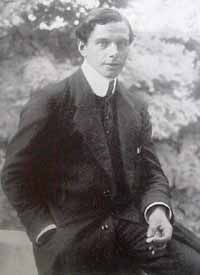
Ernst Ludwig Kirchner was born in Aschaffenburg, Germany. Originally a student of architecture, Kirchner first became interested in fine arts during a visit to Nuremberg. The traditional German engravings he saw there served as the inspiration for his earliest efforts in the field of etching. When he began to paint he was influenced by Neo-Impressionism but, by 1904, the influence of the Norwegian Expressionist
Edvard Munch and of African and oriental art helped him to simplify his use of form and color into large flat washes. The dominant member of Die Brücke, Kirchner worked with his friends in Dresden, graduated from architectural school in 1907, and then, with the members of Die Brücke, went to Berlin. It was there, between 1911 and 1914, that he painted his most famous works, portraying the eerie, worldly, and artificial life that was then typical of Berlin. He painted portraits and street scenes, locking his people in a web of rhythmic lines, distorting their forms and features into what he called "hieroglyphics," tinting them with unreal colors, and abstracting them from a reality that seems just beyond the reach of the known, and therefore haunting and hallucinatory.
While serving in the German Army, in 1916, Kirchner fell seriously ill and, in 1917, he left Germany for Switzerland, where he remained, constantly fighting against ailments, until his suicide in 1938 at Davos. The change of environment prompted a shift in the subject matter of his paintings, and the mountain landscapes and peasants of his later works are expressive of the link between man and nature. Late in the 1920's, he was much influenced by Picasso, and his work closely approached that of the Spanish artist during those years. However, his symbolic landscapes, often allegorical and even monumental in their symbolism, are more truly his own. Kirchner was also a sculptor and graphic artist, exceptionally talented in the making of woodcuts, and as forceful in black and white as in his vividly colored oil paintings.